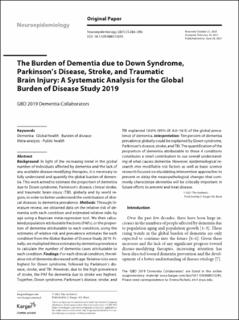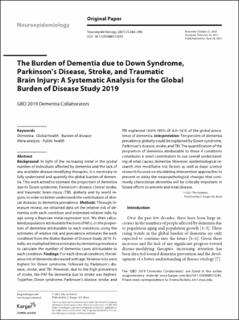| dc.contributor.author | Nichols, Emma | |
| dc.contributor.author | Abd-Allah, Foad | |
| dc.contributor.author | Kisa, Adnan | |
| dc.contributor.author | Murray, Christopher J L | |
| dc.contributor.author | Vos, Theo | |
| dc.contributor.author | Kisa, Sezer | |
| dc.contributor.author | Mokdad, Ali H. | |
| dc.contributor.author | Dementia Collaborators, GBD 2019 | |
| dc.date.accessioned | 2022-07-07T12:16:23Z | |
| dc.date.available | 2022-07-07T12:16:23Z | |
| dc.date.created | 2022-01-04T12:44:01Z | |
| dc.date.issued | 2021 | |
| dc.identifier.citation | Neuroepidemiology. 2021, 55 (4), 286-296. | en_US |
| dc.identifier.issn | 0251-5350 | |
| dc.identifier.uri | https://hdl.handle.net/11250/3003507 | |
| dc.description.abstract | Background: In light of the increasing trend in the global number of individuals affected by dementia and the lack of any available disease-modifying therapies, it is necessary to fully understand and quantify the global burden of dementia. This work aimed to estimate the proportion of dementia due to Down syndrome, Parkinson's disease, clinical stroke, and traumatic brain injury (TBI), globally and by world region, in order to better understand the contribution of clinical diseases to dementia prevalence. Methods: Through literature review, we obtained data on the relative risk of dementia with each condition and estimated relative risks by age using a Bayesian meta-regression tool. We then calculated population attributable fractions (PAFs), or the proportion of dementia attributable to each condition, using the estimates of relative risk and prevalence estimates for each condition from the Global Burden of Disease Study 2019. Finally, we multiplied these estimates by dementia prevalence to calculate the number of dementia cases attributable to each condition. Findings: For each clinical condition, the relative risk of dementia decreased with age. Relative risks were highest for Down syndrome, followed by Parkinson's disease, stroke, and TBI. However, due to the high prevalence of stroke, the PAF for dementia due to stroke was highest. Together, Down syndrome, Parkinson's disease, stroke, and TBI explained 10.0% (95% UI: 6.0-16.5) of the global prevalence of dementia. Interpretation: Ten percent of dementia prevalence globally could be explained by Down syndrome, Parkinson's disease, stroke, and TBI. The quantification of the proportion of dementia attributable to these 4 conditions constitutes a small contribution to our overall understanding of what causes dementia. However, epidemiological research into modifiable risk factors as well as basic science research focused on elucidating intervention approaches to prevent or delay the neuropathological changes that commonly characterize dementia will be critically important in future efforts to prevent and treat disease. | en_US |
| dc.description.sponsorship | R.O.A. is supported by Grant U01HG010273 from the National Institutes of Health (NIH) as part of the H3Africa Consortium and by the FLAIR fellowship funded by the UK Royal Society and the African Academy of Sciences. F.C. and E.F. acknowledge UID/MULTI/04378/2019 and UID/QUI/50006/2019 support with funding from FCT/MCTES through national funds. L.F.S.C.A. is supported by Medical Research Council (London) Grant No. MR/T03355X/1. A.G. was supported by Fondazione Umberto Veronesi. M.R.H. is supported by Ohio University Research Council (OURC) Spring 2020 funding. Y.J.K. was supported by Research Management Centre, Xiamen University Malaysia (No.: XMUMRF/2020-C6/ITCM/0004). W.A.K. is part of the Alzheimer Advisory Group to IHME sponsored by Gates Ventures and is principally supported at UW by NIH Grant U01 AG016976. M.K. would like to acknowledge FIC/NIMH K43 TW010716-03. I.L. is a member of the Sistema Nacional de Investigación (SNI), which is supported by the Secretaría Nacional de Ciencia, Tecnología e Innovación (SENACYT), Panama. S.L. acknowledges institutional support from the Competence Cluster for Nutrition and Cardiovascular Health (nutriCARD) Halle-Jena-Leipzig (Germany; German Federal Ministry of Education and Research; Grant Agreement no. 01EA1808A). N.M. acknowledges support from the National Institute of Mental Health and Neurosciences, Bengaluru, India. S.M. is supported by Grant GR-2013-02354960 from the Italian Ministry of Health. A.R., D.S., and S.S. acknowledge support by a grant from the Italian Ministry of Health (Ricerca Corrente, Fondazione Istituto Neurologico C. Besta, Linea 4 – Outcome Research: dagli Indicatori alle Raccomandazioni Cliniche). P.S.S. acknowledges funding support from the NHMRC of Australia (GNT1093083) and the NIH (USA) (1RF1AG057531-01). J.P.S. acknowledges support by Grant No. UIDB/04378/2020 from the Applied Molecular Biosciences Unit (UCIBIO), supported through Portuguese national funds via FCT/MCTES. C.E.I. acknowledges support by the National Health and Medical Research Council. C.W. acknowledges support from the Ministry of Science and Technology in China (2020YFC2005600) and the Suzhou Science and Technology Bureau SS2019069 and partial support by the Kunshan Municipal Government research funding. | en_US |
| dc.language.iso | eng | en_US |
| dc.relation.uri | https://www.karger.com/Article/FullText/515393 | |
| dc.rights | Navngivelse-Ikkekommersiell 4.0 Internasjonal | * |
| dc.rights.uri | http://creativecommons.org/licenses/by-nc/4.0/deed.no | * |
| dc.title | The Burden of Dementia due to Down Syndrome, Parkinson’s Disease, Stroke, and Traumatic Brain Injury: A Systematic Analysis for the Global Burden of Disease Study 2019 | en_US |
| dc.type | Peer reviewed | en_US |
| dc.type | Journal article | en_US |
| dc.description.version | publishedVersion | en_US |
| dc.source.pagenumber | 286-296 | en_US |
| dc.source.volume | 55 | en_US |
| dc.source.journal | Neuroepidemiology | en_US |
| dc.source.issue | 4 | en_US |
| dc.identifier.doi | 10.1159/000515393 | |
| dc.identifier.cristin | 1974308 | |
| cristin.ispublished | true | |
| cristin.fulltext | original | |
| cristin.fulltext | original | |
| cristin.qualitycode | 1 | |


